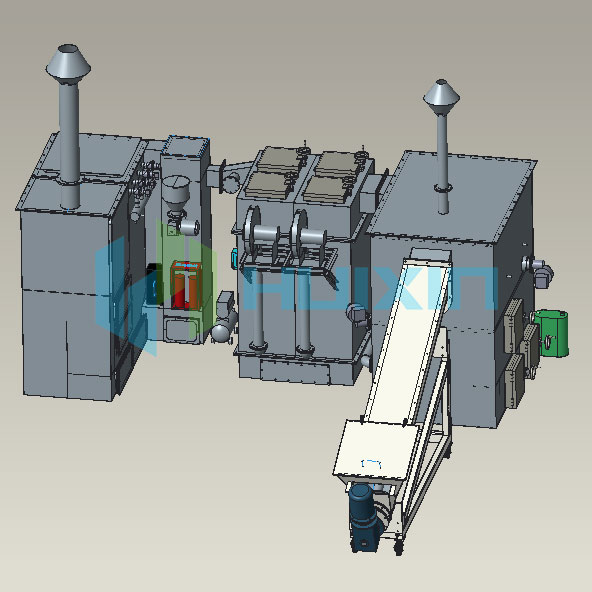Waste Types Suitable for Environmental Friendly Waste Incinerators: Capabilities and Limitations
2024-06-27
Environmental Friendly Waste Incinerators (EFWIs) have emerged as a sustainable solution for waste management, designed to minimize harmful emissions and maximize energy recovery. However, not all types of waste are equally suitable for processing in these advanced incinerators. Understanding what types of waste can be effectively processed in EFWIs, as well as their limitations, is crucial for optimizing their use and ensuring environmental safety. In this blog, we will explore the types of waste suitable for Environmental Friendly Waste Incinerators and discuss any inherent limitations.
Suitable Waste Types for EFWIs
1. Municipal Solid Waste (MSW)
Municipal Solid Waste, commonly known as household or urban waste, is one of the primary waste types processed in EFWIs.
- Components: This includes everyday items like paper, plastics, glass, metals, food scraps, and yard waste.
- Processing Benefits: EFWIs efficiently reduce the volume of MSW while recovering energy, making it a valuable source of renewable energy.
2. Industrial Waste
Industrial waste generated from manufacturing and production processes can be effectively processed in EFWIs.
- Components: This includes packaging materials, plastics, textiles, rubber, and certain chemicals.
- Processing Benefits: Proper incineration of industrial waste in EFWIs reduces landfill use and recovers energy, while advanced emission controls mitigate the release of harmful pollutants.
3. Medical Waste
Medical waste, which poses significant health and environmental risks if not properly managed, can be safely processed in EFWIs.
- Components: This includes used medical instruments, contaminated disposables, pharmaceuticals, and biological waste.
- Processing Benefits: EFWIs sterilize and safely dispose of hazardous medical waste, preventing the spread of infections and contamination.
4. Hazardous Waste
Certain types of hazardous waste, such as chemicals and contaminated materials, can be processed in specially designed EFWIs.
- Components: This includes toxic chemicals, solvents, paints, and contaminated materials.
- Processing Benefits: EFWIs equipped with advanced pollution control technologies can safely neutralize hazardous substances, minimizing environmental and health risks.
5. Agricultural Waste
Agricultural waste generated from farming activities is another type of waste suitable for EFWIs.
- Components: This includes crop residues, animal manure, and processing waste from food production.
- Processing Benefits: Incinerating agricultural waste in EFWIs reduces methane emissions from decomposition and produces energy, contributing to a circular economy.
Limitations of EFWIs
While EFWIs are versatile and efficient, there are certain limitations and types of waste that are not suitable for processing in these incinerators.
1. Electronic Waste (E-Waste)
E-waste, which includes discarded electronic devices and components, poses significant challenges for EFWIs.
- Components: This includes computers, smartphones, televisions, and batteries.
- Limitations: E-waste contains valuable metals and hazardous substances that require specialized recycling processes rather than incineration. Incinerating e-waste can release toxic substances such as lead, mercury, and cadmium.
2. Radioactive Waste
Radioactive waste from nuclear power plants and medical facilities is not suitable for EFWIs.
- Components: This includes spent nuclear fuel, contaminated equipment, and radioactive isotopes.
- Limitations: EFWIs are not designed to handle radioactive materials, which require specific containment, storage, and disposal methods to ensure safety.
3. Large Quantities of Inert Waste
Inert waste, which does not decompose or produce energy when incinerated, is not ideal for EFWIs.
- Components: This includes construction and demolition debris such as concrete, bricks, and glass.
- Limitations: Inert waste does not contribute to energy recovery and can take up valuable capacity within the incinerator.
4. High-Moisture Waste
Waste with high moisture content can pose challenges for efficient incineration.
- Components: This includes wet food waste, sludge, and certain agricultural residues.
- Limitations: High moisture content reduces the calorific value of the waste, making it less efficient to burn and requiring more energy to achieve complete combustion.
5. Highly Toxic Chemicals
Certain highly toxic chemicals and industrial by-products may not be suitable for standard EFWIs.
- Components: This includes specific industrial chemicals, pesticides, and materials with extremely high toxicity.
- Limitations: These substances may require specialized incinerators or chemical treatment processes to ensure safe and complete neutralization.
Conclusion
Environmental Friendly Waste Incinerators play a crucial role in sustainable waste management by efficiently processing a wide range of waste types while minimizing harmful emissions. They are particularly effective for municipal solid waste, industrial waste, medical waste, hazardous waste, and agricultural waste. However, they have limitations when it comes to e-waste, radioactive waste, inert waste, high-moisture waste, and highly toxic chemicals. Understanding these capabilities and limitations is essential for optimizing the use of EFWIs and ensuring environmentally responsible waste management. By leveraging the strengths of EFWIs and addressing their limitations, we can move towards a cleaner, more sustainable future.



